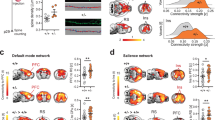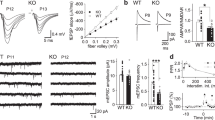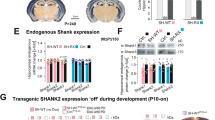Abstract
Shank3 monogenic mutations lead to autism spectrum disorders (ASD). Shank3 is part of the glutamate receptosome that physically links ionotropic NMDA receptors to metabotropic mGlu5 receptors through interactions with scaffolding proteins PSD95–GKAP–Shank3–Homer. A main physiological function of the glutamate receptosome is to control NMDA synaptic function that is required for plasticity induction. Intact glutamate receptosome supports glutamate receptors activation and plasticity induction, while glutamate receptosome disruption blocks receptors activity, preventing the induction of subsequent plasticity. Despite possible impact on metaplasticity and cognitive behaviors, scaffold interaction dynamics and their consequences are poorly defined. Here, we used mGlu5–Homer interaction as a biosensor of glutamate receptosome integrity to report changes in synapse availability for plasticity induction. Combining BRET imaging and electrophysiology, we show that a transient neuronal depolarization inducing NMDA-dependent plasticity disrupts glutamate receptosome in a long-lasting manner at synapses and activates signaling pathways required for the expression of the initiated neuronal plasticity, such as ERK and mTOR pathways. Glutamate receptosome disruption also decreases the NMDA/AMPA ratio, freezing the sensitivity of the synapse to subsequent changes of neuronal activity. These data show the importance of a fine-tuning of protein–protein interactions within glutamate receptosome, driven by changes of neuronal activity, to control plasticity. In a mouse model of ASD, a truncated mutant form of Shank3 prevents the integrity of the glutamate receptosome. These mice display altered plasticity, anxiety-like, and stereotyped behaviors. Interestingly, repairing the integrity of glutamate receptosome and its sensitivity to the neuronal activity rescued synaptic transmission, plasticity, and some behavioral traits of Shank3∆C mice. Altogether, our findings characterize mechanisms by which Shank3 mutations cause ASD and highlight scaffold dynamics as new therapeutic target.
This is a preview of subscription content, access via your institution
Access options
Subscribe to this journal
Receive 12 print issues and online access
$259.00 per year
only $21.58 per issue
Buy this article
- Purchase on Springer Link
- Instant access to full article PDF
Prices may be subject to local taxes which are calculated during checkout





Similar content being viewed by others
References
Bourgeron T. From the genetic architecture to synaptic plasticity in autism spectrum disorder. Nat Neurosci. 2015;16:551–63.
Durand CM, Betancur C, Boeckers TM, Bockmann J, Chaste P, Fauchereau F, et al. Mutations in the gene encoding the synaptic scaffolding protein SHANK3 are associated with autism spectrum disorders. Nat Genet. 2007;39:25–7.
Carbonetto S. A blueprint for research on shankopathies: a view from research on autism spectrum disorder. Dev Neurobiol. 2013;74:85–112.
Betancur C, Buxbaum JD. SHANK3 haploinsufficiency: a “common” but underdiagnosed highly penetrant monogenic cause of autism spectrum disorders. Mol Autism. 2013;4:1.
Leblond CS, Nava C, Polge A, Gauthier J, Huguet G, Lumbroso S, et al. Meta-analysis of SHANK mutations in autism spectrum disorders: a gradient of severity in cognitive impairments. PLoS Genet. 2014;10:e1004580.
Duffney LJ, Wei J, Cheng J, Liu W, Smith KR, Kittler JT, et al. Shank3 deficiency induces NMDA receptor hypofunction via an actin-dependent mechanism. J Neurosci. 2013;33:15767–78. http://www.jneurosci.org/cgi/doi/10.1523/JNEUROSCI.1175-13.2013.
Kouser M, Speed HE, Dewey CM, Reimers JM, Widman AJ, Gupta N, et al. Loss of predominant Shank3 isoforms results in hippocampus-dependent impairments in behavior and synaptic transmission. J Neurosci. 2013;33:18448–68. http://www.pubmedcentral.nih.gov/articlerender.fcgi?artid=3834052&tool=pmcentrez&rendertype=abstract.
Duffney LJ, Zhong P, Wei J, Matas E, Cheng J, Qin L, et al. Autism-like deficits in Shank3-deficient mice are rescued by targeting actin regulators. Cell Rep. 2015;11:1400–13.
Sala C, Vicidomini C, Bigi I, Mossa A, Verpelli C. Shank synaptic scaffold proteins: keys to understanding the pathogenesis of autism and other synaptic disorders. J Neurochem. 2015;135:849–58.
Qinin L, Ma K, Wang ZJ, Hu Z, Matas E, Wei J, et al. Social deficits in Shank3-deficient mouse models of autism are rescued by histone deacetylase (HDAC) inhibition. Nat Neurosci. 2018;21:564–75.
Bonaglia MC, Giorda R, Borgatti R, Felisari G, Gagliardi C, Selicorni A, et al. Disruption of the ProSAP2 gene in a t(12;22)(q24.1;q13.3) is associated with the 22q13.3 deletion syndrome. Am J Hum Genet. 2001;69:261–8.
Sheng M, Kim E. The postsynaptic organization of synapses. Cold Spring Harb Perspect Biol. 2011;3:a005678.
Naisbitt S, Kim E, Tu JC, Xiao B, Sala C, Valtschanoff J, et al. Shank, a novel family of postsynaptic density proteins that binds to the NMDA receptor/PSD-95/GKAP complex and cortactin. Neuron. 1999;23:569–82.
Tu JC, Xiao B, Naisbitt S, Yuan JP, Petralia RS, Brakeman P, et al. Coupling of mGluR/Homer and PSD-95 complexes by the Shank family of postsynaptic density proteins. Neuron. 1999;23:583–92.
Boeckers TM, Bockmann J, Kreutz MR, Gundelfinger ED. ProSAP/Shank proteins—a family of higher order organizing molecules of the postsynaptic density with an emerging role in human neurological disease. J Neurochem. 2002;81:903–10.
Hayashi MK, Tang C, Verpelli C, Narayanan R, Stearns MH, Xu R, et al. The postsynaptic density proteins Homer and Shank form a polymeric network structure. Cell. 2009;137:159–71.
Monteiro P, Feng G. SHANK proteins: roles at the synapse and in autism spectrum disorder. Nat Rev Neurosci. 2017;18:147–57.
Bruneau EG, Esteban JA, Akaaboune M. Receptor‐associated proteins and synaptic plasticity. FASEB J. 2009;23:679–88.
Scheefhals N, MacGillavry HD. Functional organization of postsynaptic glutamate receptors. Mol Cell Neurosci. 2018;91:82–94.
Christopher M. Synaptic activity induces input-specific rearrangements in a targeted synaptic protein interaction network. Physiol Behav. 2016;176:100–6.
Moutin E, Raynaud F, Roger J, Pellegrino E, Homburger V, Bertaso F, et al. Dynamic remodeling of scaffold interactions in dendritic spines controls synaptic excitability. J Cell Biol. 2012;198:251–63.
Xiao B, Tu JC, Petralia RS, Yuan JP, Doan A, Breder CD, et al. Homer regulates the association of group 1 metabotropic glutamate receptors with multivalent complexes of Homer-related, synaptic proteins. Neuron. 1998;21:707–16.
Beneken J, Tu JC, Xiao B, Nuriya M, Yuan JP, Worley PF, et al. Structure of the Homer EVH1 domain-peptide complex reveals a new twist in polyproline recognition. Neuron. 2000;26:143–54.
Hayashi MK, Ames HM, Hayashi Y. Tetrameric hub structure of postsynaptic scaffolding protein Homer. J Neurosci. 2006;26:8492–501.
Perroy J, Raynaud F, Homburger V, Rousset M-C, Telley L, Bockaert J, et al. Direct interaction enables cross-talk between ionotropic and group I metabotropic glutamate receptors. J Biol Chem. 2008;283:6799–805. http://www.ncbi.nlm.nih.gov/pubmed/18182392.
Goyet E, Bouquier N, Ollendorff V, Perroy J. Fast and high resolution single-cell BRET imaging. Sci Rep. 2016;6:1–12.
Bouquierouquier N, Moutin E, Tintignac LA, Reverbel A, Jublanc E, Sinnreich M, et al. AIMTOR, a BRET biosensor for live imaging, reveals subcellular mTOR signaling and dysfunctions. BMC Biol. 2020;18:1–17.
Ronesi JA, Collins KA, Hays SA, Tsai NP, Guo W, Birnbaum SG, et al. Disrupted Homer scaffolds mediate abnormal mGluR5 function in a mouse model of fragile X syndrome. Nat Neurosci. 2012;15:431–40.
Moutin E, Hemonnot A-L, Seube V, Linck N, Rassendren F, Perroy J, et al. Procedures for culturing and genetically manipulating murine hippocampal postnatal neurons. Front Synaptic Neurosci. 2020;12:19.
Coulon V, Audet M, Homburger V, Bockaert J, Fagni L, Bouvier M, et al. Subcellular imaging of dynamic protein interactions by bioluminescence resonance energy transfer. Biophys J. 2008;94:1001–9.
Chastagnier Y, Moutin E, Hemonnot A, Perroy J. Image processing for bioluminescence resonance energy transfer measurement—BRET-analyzer. Front Comput Neurosci. 2018;11:1–8.
De Bundel D, Zussy C, Espallergues J, Gerfen CR, Girault JA, Valjent E. Dopamine D2 receptors gate generalization of conditioned threat responses through mTORC1 signaling in the extended amygdala. Mol Psychiatry. 2016;21:1545–53.
Bading H, Ginty DD, Greenberg ME. Regulation of gene expression in hippocampal neurons by distinct calcium signaling pathways. Science. 1993;260:181–6.
Sergé A, Fourgeaud L, Hémar A, Choquet D. Receptor activation and homer differentially control the lateral mobility of metabotropic glutamate receptor 5 in the neuronal membrane. J Neurosci. 2002;22:3910–20.
Aloisi E, Corf K Le, Dupuis J, Zhang P, Ginger M, Labrousse V, et al. Altered surface mGluR5 dynamics provoke synaptic NMDAR dysfunction and cognitive defects in Fmr1 knockout mice. Nat Commun. 2017. https://doi.org/10.1038/s41467-017-01191-2.
Araki Y, Zeng M, Zhang M, Huganir RL. Rapid dispersion of SynGAP from synaptic spines triggers AMPA receptor insertion and spine enlargement during LTP. Neuron. 2015;85:173–89.
Drapeau E, Riad M, Kajiwara Y, Buxbaum JD. Behavioral phenotyping of an improved mouse model of Phelan—McDermid syndrome with a complete deletion of the Shank3 gene. eNeuro 2018;5:ENEURO.0046-18.
Yang M, Bozdagi O, Scattoni ML, Wöhr M, Roullet FI, Katz AM, et al. Reduced excitatory neurotransmission and mild Autism-Relevant phenotypes in adolescent shank3 null mutant mice. J Neurosci. 2012;32:6525–41.
Jaramillo TC, Speed HE, Xuan Z, Reimers JM, Liu S, Powell CM. Altered striatal synaptic function and abnormal behaviour in Shank3 Exon4-9 deletion mouse model of autism. Autism Res. 2016;9:350–75.
Drapeau E, Dorr NP, Elder GA, Buxbaum JD. Absence of strong strain effects in behavioral analyses of Shank3-deficient mice. Dis Model Mech. 2014;7:667–81.
Wang X, Bey AL, Katz BM, Badea A, Kim N, David LK, et al. Altered mGluR5-Homer scaffolds and corticostriatal connectivity in a Shank3 complete knockout model of autism. Nat Commun. 2016;7:1–18.
Guo W, Ceolin L, Collins KA, Perroy J, Huber KM. Elevated CaMKIIα and hyperphosphorylation of homer mediate circuit dysfunction in a fragile X syndrome mouse model. Cell Rep. 2015;13:2297–311. http://www.pubmedcentral.nih.gov/articlerender.fcgi?artid=4685008&tool=pmcentrez&rendertype=abstract.
Chokshi V, Gao M, Grier BD, Owens A, Wang H, Worley PF, et al. Input-specific metaplasticity in the visual cortex requires Homer1a-mediated mGluR5 signaling. Neuron. 2019;104:736–48.e6.
Hu J-H, Park JM, Park S, Xiao B, Dehoff MH, Kim S, et al. Homeostatic scaling requires group I mGluR activation mediated by Homer1a. Neuron. 2010;68:1128–42.
Diering GH, Nirujogi RS, Roth RH, Worley PF, Pandey A, Huganir RL. Homer1a drives homeostatic scaling-down of excitatory synapses during sleep. Science. 2017;515:511–5.
Vazdarjanova A, McNaughton BL, Barnes CA, Worley PF, Guzowski JF. Experience-dependent coincident expression of the effector immediate-early genes Arc and Homer 1a in hippocampal and neocortical neuronal networks. J Neurosci. 2002;22:10067–71.
English JD, Sweatt JD. A requirement for the mitogen-activated protein kinase cascade in hippocampal long term potentiation. J Biol Chem. 1997;272:19103–6.
Schafe GE, Atkins CM, Swank MW, Bauer EP, Sweatt JD, Ledoux JE. Activation of ERK/MAP kinase in the amygdala is required for memory consolidation of Pavlovian fear conditioning. J Neurosci. 2000;20:8177–87.
Bockaert J, Marin P. mTOR in brain physiology and pathologies. Physiol Rev. 2015;95:1157–87.
Hoeffer CA, Klann E. mTOR signaling: at the crossroads of plasticity, memory and disease. Trends Neurosci. 2010;33:67–75.
Cammalleri M, Lütjens R, Berton F, King AR, Simpson C, Francesconi W, et al. Time-restricted role for dendritic activation of the mTOR-p70 S6K pathway in the induction of late-phase long-term potentiation in the CA1. Proc Natl Acad Sci USA. 2003;100:14368–73.
Huber KM, Klann E, Costa-Mattioli M, Zukin RS. Dysregulation of mammalian target of rapamycin signaling in mouse models of autism. J Neurosci. 2015;35:13836–42.
Sharma A, Hoeffer CA, Takayasu Y, Miyawaki T, McBride SM, Klann E, et al. Dysregulation of mTOR signaling in fragile X syndrome. J Neurosci. 2010;30:694–702.
Leuner B, Shors TJ. Stress, anxiety, and dendritic spines: what are the connections? Neuroscience. 2013;251:108–19.
Mennesson M, Orav E, Gigliotta A, Kulesskaya N, Saarnio S, Kirjavainen A, et al. Kainate receptor auxiliary subunit NETO2-related cued fear conditioning impairments associate with defects in amygdala development and excitability. eNeuro. 2020;7:ENEURO.0541-19.2020.
Sathyanesan A, Gallo V. Cerebellar contribution to locomotor behavior: a neurodevelopmental perspective. Neurobiol Learn Mem. 2019;165:106861.
Petrosini L, Cutuli D, Picerni E, Laricchiuta D. Viewing the personality traits through a cerebellar lens: a focus on the constructs of novelty seeking, harm avoidance, and alexithymia. Cerebellum. 2017;16:178–90.
Mei Y, Monteiro P, Zhou Y, Kim J-A, Gao X, Fu Z, et al. Adult restoration of Shank3 expression rescues selective autistic-like phenotypes. Nature. 2016;530:481–4.
Vicidomini C, Ponzoni L, Lim D, Schmeisser MJ, Reim D, Morello N, et al. Pharmacological enhancement of mGlu5 receptors rescues behavioral deficits in SHANK3 knock-out mice. Mol Psychiatry. 2016:1–14. https://doi.org/10.1038/mp.2016.30.
Nardecchia F, Orlando R, Iacovelli L, Colamartino M, Fiori E, Leuzzi V, et al. Targeting mGlu5 metabotropic glutamate receptors in the treatment of cognitive dysfunction in a mouse model of phenylketonuria. Front Neurosci. 2018;12:1–12.
Acknowledgements
The authors thank the iExplore animal facility (IGF, Montpellier), CompAn behavioral phenotyping facility (MMDN, Montpellier), and the Arpege platform (IGF, Montpellier) for the use of the Infinite F500 plate reader for cell-population BRET. The authors thank Muriel Asari for illustrations. The authors thank Hélène Hirbec for helping with statistical analysis and Giorgio Cignitti for helping with patch on slices. The authors also gratefully acknowledge Paul F. Worley for the generous gift of the Shank3∆C mouse model. The authors truly thank Dr. Amanda Hernan for proofreading. This work was supported by the Agence Nationale de la Recherche (VC, ANR-18-CE16-0011-01) and the European Research Council (ERC) under the European Union’s Horizon 2020 research and innovation programme (JP, grant agreement No. 646788), ANR Lanthslider (JP, ANR-17-CE11-0046), Comitato Telethon Fondazione Onlus (grant no. GGP16131 to CV and GGP17176 to CS), and Regione Lombardia NeOn Progetto “NeOn” POR-FESR 2014-2020, ID 239047, CUP E47F17000000009 to CS and CV).
Author information
Authors and Affiliations
Contributions
EM and JP conceived research and wrote the manuscript; JP, EM, VC, CV, CS, TM, EA, LG, NBo, and SS designed research experiments; VC, NBo, and FG cloned all plasmids. VC and EM produced viruses. EM performed cell-population BRET experiments; EM, JP, VS, and A-LH-G performed microscopy BRET experiments. EG performed single particle training experiments. NBe analyzed single particle training experiments, with the help of EG and LG. Author EM performed electrophysiology in slices, with the help of EA and FR. Author VC performed coimmunoprecipitations with the help of EM and NBo. Authors CV, CS, and FG designed and characterized the Homer–GluN2B construct. EM performed synaptosomes preparations. NBo and EM performed immunohistochemistry on injected brains. SS performed surgery and viral injections. SS, BG, and JA performed behavioral experiments with the help of TM. Author YC developed toolsets for BRET analysis. JP supervised the project. All authors contributed to the preparation of the manuscript and approved it.
Corresponding authors
Ethics declarations
Competing interests
The authors declare no competing interests.
Additional information
Publisher’s note Springer Nature remains neutral with regard to jurisdictional claims in published maps and institutional affiliations.
Supplementary information
Rights and permissions
About this article
Cite this article
Moutin, E., Sakkaki, S., Compan, V. et al. Restoring glutamate receptosome dynamics at synapses rescues autism-like deficits in Shank3-deficient mice. Mol Psychiatry 26, 7596–7609 (2021). https://doi.org/10.1038/s41380-021-01230-x
Received:
Revised:
Accepted:
Published:
Issue Date:
DOI: https://doi.org/10.1038/s41380-021-01230-x
This article is cited by
-
Combined expansion and STED microscopy reveals altered fingerprints of postsynaptic nanostructure across brain regions in ASD-related SHANK3-deficiency
Molecular Psychiatry (2024)
-
Rare genetic brain disorders with overlapping neurological and psychiatric phenotypes
Nature Reviews Neurology (2024)
-
Restoration of nNOS Expression Rescues Autistic-Like Phenotypes Through Normalization of AMPA Receptor-Mediated Neurotransmission
Molecular Neurobiology (2024)
-
mGluR5 is transiently confined in perisynaptic nanodomains to shape synaptic function
Nature Communications (2023)



